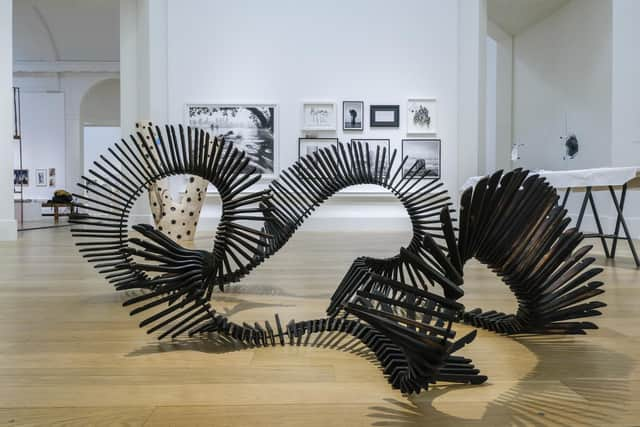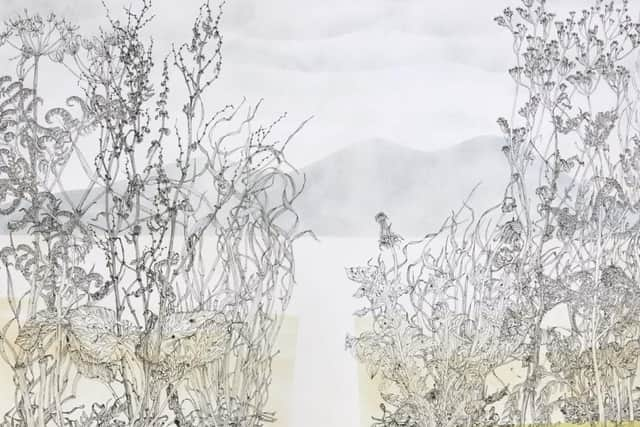Art reviews: Then and Now: 100 Years of Visual Arts Scotland | After Gillies | Philip Braham | Clive Ramage
Then and Now: 100 Years of Visual Arts Scotland, Royal Scottish Academy, Edinburgh ****
After Gillies, Royal Scottish Academy, Edinburgh ***
Philip Braham: Prescient Nature, Scottish Gallery, Edinburgh ****
Advertisement
Hide AdClive Ramage: Northern Lights, Graystone Gallery, Edinburgh ***
Scottish Women Artists was an exhibiting society formed in 1924. It kept its name and gender until the present century, but then changed it, first to Scottish Artists and Artist Craftsmen and then to its present incarnation as Visual Arts Scotland. There was no break in continuity or mission in these name changes and so, if not by name, 2024 is nevertheless the centenary of the organisation.
By 1924 women artists were already playing their full part in the art life of Scotland. Dorothy Johnston was the star student of Edinburgh College of Art in 1912 and went on to teach there. Anne Redpath’s career had already begun. Penelope Beaton was already teaching at the college where she taught William Gillies and was still there to teach Elizabeth Blackadder 30 years later. Alice Meredith Williams was the lead sculptor in the Scottish National War Memorial. Building began early in 1924 and so this is also its centenary. In the memorial, too, she created a monument to Scottish women. The women who served directly in the war have their own memorial, including a beautiful window, but Williams also created a memorial that was, uniquely, to the suffering and sacrifice of the women who stayed at home. The convictions that inspired these monuments also have a bearing on the creation of Scottish Women Artists which, we are told, had “the aim to empower women after their contribution to the war effort.” The new society was also “to provide women with the opportunity to exhibit and create applied arts, an opportunity other arts organisations in Scotland did not encourage.”
This ambition to be inclusive of all media was clearly reflected in the organisation’s first name change to Scottish Artists and Artist Craftsmen, nor has it been lost sight of since. With the title Then and Now: 100 Years of Visual Arts Scotland, this centenary show includes 242 artists and over 300 artworks “ranging from ceramics, paintings, mixed media, photography, sculpture, and a variety of contemporary art forms.” Indeed they also include furniture, weaving, jewellery and silver and the show which we are told is the society’s largest ever is wonderfully diverse. Work on the walls inevitably dominates but there is much to look at scattered around the floors as well. There is, for instance, a rather beautiful, life-size coracle by Jenny Pope titled Buoyancy for unprecedented times. The Sleeper by Kate Davies and David Moore is also a boat but made of polished stainless steel and bronze, while Fork by Richard Goldsworthy is the upside-down fork of a tree. Painted with spots it looks like a pair of upturned legs in spotty pyjamas. Hairy Heights by Susie Johnston, a “repurposed damaged ladder” decorated with dog hair, is equally surreal. Jeff Zimmer’s Left-Over, a composition of clocks and a fireplace, has eloquent echoes of De Chirico and Magritte, while Lucia Sheppard’s Still Connections, a glass telephone, seems to be a charming homage to Dalí.


There are also a great many beautiful things here. Martha Ellis’s Grasses, for instance, is a set of four supremely delicate images of grasses made from laser cut MDF. Lisa Fenton O’Brien’s Raintrees, a lovely drawing of trees, is done, says the artist, with ink and raindrops. Victoria Fifield’s Power Struggle is a nicely observed painting of what seems to be an Indian backyard where the graffiti and the tangled power lines are added as collage. Jane Hunter’s Surface Tension is a beautiful abstract painting in blue and grey enlivened by a single line of yellow. Benloch Red and Peacock Close by Ros Lawless are also both abstract compositions and made with overlapping planes of colour. Lindsay Lavender’s BALANCE looks abstract at first, but is actually an intriguing composition of light and shadow looking down a staircase. Frederick Jones’s print, Parallel Time Zone, also makes play with a staircase. One of the most striking works here, however, is a very big painting on unstretched paper by Mary Walters. Its title is Ilulissat (Icebergs.) Ilulissat is in Greenland. Tempo, Dappled Light by Jean Gillespie is a lithograph and much smaller, but it deploys freedom of execution to achieve a similarly satisfactory effect.
Textiles of various kinds are always a distinctive feature the VAS show. This year is no exception. Fiona Hutchison’s Turning the Tide is a waterfall of tangled blue and white. Molly Shearer’s Gamfer is a tall, monochrome and loosely woven hanging. With a composition of sweeping marks like brushstrokes, Lily Roscoe’s Cocoon Series III is made of knotted woollen fibre, but looks like a stand of tall, woolly spears. Ceramics feature significantly too. Harriet Helman’s stoneware and porcelain pieces, made, she says, in collaboration with the Atlantic Sea, are strikingly abstract. Anupa Gardner’s porcelain Reef Bone is a still-life of seaweed and sea anemones and Catherine Maskell’s Don’t Cry a beautiful, if non-functional bottle.
Advertisement
Hide AdMuch of the imagery here is abstract, or semi-abstract, but there are some striking figurative works too. MaryAnn Hunt’s Firefly is a small painting of a figure with flaming hair, while Joyce Gunn Cairns’s Pregnant with Hope is a life-size painting of a touchingly vulnerable pregnant woman. Altogether the variety in this show is really striking and reflects well how the society’s ambition continues undimmed after a hundred years. There is apparently some resistance to putting the whole show online, however. That’s a shame, for it would reach a much wider audience.
In one of the galleries adjacent to the VAS show, the RSA has put on After Gillies. It is literally after Gillies, who was the subject of the previous show in the same gallery, but it is also seems to aim to open up the topic and consider a little bit of Gillies’s legacy. There are 16 artists including Kate Downie, Barbara Rae, Lennox Dunbar, Paul Furneaux, Sam Ainslie and others, all members of the Academy. There is also a token presence of Gillies himself with two pictures. The works are accompanied by statements by the artists and for a good many Gillies’s legacy has been literal. They have received grants from the Gillies bequest to the RSA. Some, including James Fairgrieve, George Donald and Michael Doherty do have memories of Gillies himself. They were not taught by him, but his legacy was powerful for those he did teach. Represented here by single works by Elizabeth Blackadder and John Houston, they and their contemporaries are the real “After Gillies” generation. Among them, Frances Walker is still working, but is not included here. Really, it is all a bit miscellaneous.


Advertisement
Hide AdAs this show’s parameters seem so vague, Philip Braham could equally have been included, but instead he is currently having a one-man show at the Scottish Gallery. Its title, Prescient Nature, seems to be a reference to the sense he conjures of a presence in the landscapes he records. He paints trees against the light, dark skies, mists, snow, ruined forests and reflections in standing water. His pictures are strong in mood and sometimes this is ominous, too. Mostly they are almost monochromatic, but occasionally lit by a scarlet sunset, or a deep blue sky over a dark sea. There is a strong sense of inner reflection of the outer world in them, something perhaps akin to Caspar David Friedrich.
Meanwhile, the Graystone Gallery in Hamilton Place in Edinburgh is a new venture and is currently showing prints and paintings by Clive Ramage. I have noticed Ramage’s prints several times in group shows and the assembly of them here is certainly impressive.
Then and Now until 13 March; After Gillies until 3 March; Philip Braham until 2 March; Clive Ramage until 10 March